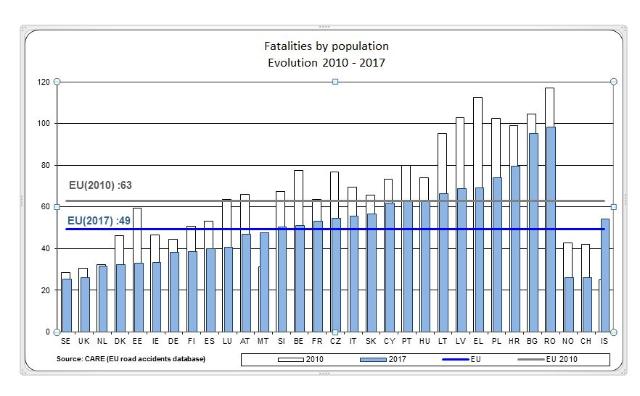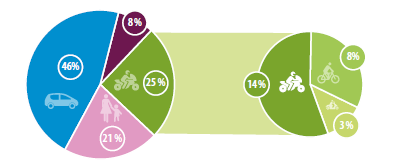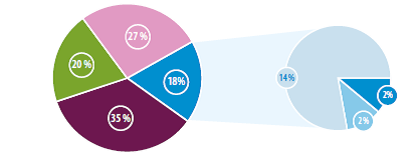EU
Estadístiques de #RoadSafety 2017: què hi ha darrere de les xifres?

 European roads remain the safest in the world: in 2017, the EU counted 49 road fatalities per one million inhabitants, against 174 deaths per million globally. According to data from the World Health Organization[1], about 1.3 million people die each year on the world's roads, of which 25,300 lost their lives in the EU last year.
European roads remain the safest in the world: in 2017, the EU counted 49 road fatalities per one million inhabitants, against 174 deaths per million globally. According to data from the World Health Organization[1], about 1.3 million people die each year on the world's roads, of which 25,300 lost their lives in the EU last year.
Thanks to decisive action at local, national and EU level, the EU has made impressive progress over the past decades. However, the progress rate has lately slowed down. After two years of stagnation (2014 and 2015), the number of road fatalities was reduced by 2% in 2016, and by another 2% in 2017. While the last two years give rise to some optimism, it will be very challenging for the EU to reach its ambitious target of halving the number of road deaths between 2010 and 2020[2]. Further efforts are therefore needed by all actors to improve road safety.
Graph 1: EU fatalities and targets 2001-2020

For every person killed in traffic crashes, about five more suffer serious injuries with life-changing consequences. Serious injuries are common and often more costly to the society because of long-time rehabilitation and healthcare needs. The Commission estimates that 135 000 people are seriously injured on Europe' roads every year.[3] The majority of those are vulnerable road users, i.e. pedestrians, cyclists and drivers of powered two-wheelers. Their proportion is even higher in towns and cities.
How did the Member States perform in reducing the number of road fatalities in 2017?
As an overall trend, the performance gap between EU member states has been narrowing year after year. Following a pronounced discrepancy in member states' road safety records in the 1970s and 1990s, a clear convergence began in 2000. Last year, only two EU member states recorded a fatality rate higher than 80 deaths per million inhabitants, against seven in 2010. In 2017, the majority of member states had a road fatality rate below 60 deaths per million inhabitants, and eight of them stood below 40 deaths per million inhabitants.
Graph 2: Fatalities per million inhabitants by country – evolution 2010-2017

In 2017, Member States with the best road safety scores were Sweden (25) and the UK (27), followed by the Netherlands (31), Denmark (32), Ireland (33) and Estonia (36). On the other hand, Member States with the highest fatality rate were Romania (98) and Bulgaria (96). While the EU average decrease in the number of road deaths from 2016 to 2017 was only 2%, some countries made much more progress, such as Estonia with -32% and Slovenia with -20%.
In the period 2010-2017, Greece reported the biggest drop in road fatalities (-41%), followed by Estonia (-39%), Latvia (-38%) and Lithuania (-36%). During the same period, the EU average was of minus 20%.
Which types of roads and which users are the most affected?
Graph 3: Road fatalities in the EU by type of roads

Overall, only 8% of road fatalities in 2017 occurred on motorways versus 55% on rural roads, and 37% in urban areas.
Graph 4: Road fatalities in the EU by transport mode

In 2017, vulnerable road users accounted for almost half of the road victims. 21% of all people killed on roads were pedestrians, 25% two-wheelers (14% were motorcyclists, 8% were cyclists and 3% mopeds riders). Pedestrian and cyclist fatalities have decreased at a lower rate than other fatalities (by respectively 15% and 2% from 2010 to 2016, compared to the overall fatality decrease of 20%).
Graph 5: Road fatalities in the EU by age


More than 3.000 young people die yearly in road crashes in the EU. Almost 14% of people killed on EU roads are aged between 18 and 24, while only 8% of the population falls within this age group. Young people are far more likely to be victims of road crashes than any other age group. Due to demographic changes in the European societies, the proportion of elderly fatalities has also risen over the last years (22% in 2010 to 27% in 2017).
Who are the main actors when it comes to road safety?
EU member states are still the main actors in improving road safety, as the biggest part of road safety policies falls under the principle of subsidiarity (e.g. setting the maximum speed allowed). Therefore, Member States are invited to step up actions, in particular focusing on enforcement of traffic rules, as well as education and raising awareness. The Commission supports Member States in these efforts:
- By bringing together policymakers, experts, NGOs and the industry in several forums, such as the High Level Group on road safety, expert committees, seminars and European road safety events.
- A través de l' European Road Safety Charter, a large platform managed by the Commission, with more than 3 500 members today. The Charter mobilizes public and private entities as well as the civil society in all the 28 EU countries for voluntary commitments to road safety actions.
- El European Day Without a Road Death, co-organized with the European Traffic Police Network during the European Mobility Week, is a Europe-wide awareness-raising campaign on road safety risks.
- Through studies and projects co-funded by the EU. The SafetyCube research project, funded under H2020, has developed a new web based information resource for road safety policy-makers and stakeholders.
What are the next steps at EU level?
El Valletta Declaration on Road Safety, endorsed at a Ministerial Conference in March 2017 and adopted as Council Conclusions, marks far-reaching commitments by Member States, particularly on serious injuries with a new reduction target of 50% between 2020 and 2030. With the backing of this strong political signal, the Commission is now working on an ambitious new road safety policy framework for the period 2020-2030. The objective is to respond better to new challenges by focusing on closer cooperation between all road safety actors, better monitoring and targeted funding. This new policy framework will be accompanied by a series of concrete measures contributing to safer roads and with strong EU value added. Actions under consideration include:
- Vehicle safety: taking the latest technological developments such as driver's assistance systems into account to avoid accidents and protect pedestrians and cyclists.
- Infrastructure safety management: increasing transparency of procedures and working towards an equal level of infrastructure safety.
- Cooperative, connected and autonomous mobility: guaranteeing a safe transition to these technologies, which offer potential in reducing driver errors (responsible for around 90% of accidents) but also create new challenges, such as the safe interaction with other road users.
The Commission is planning to present these initiatives in spring 2018.
Més informació
All information, statistics and best practices as well as studies and project reports can be found on the Commission website.
Informació específica del país
Àustria: Austria's road safety performance has improved more than the EU average from the beginning of the decade, coming down to 47 deaths per million inhabitants in 2017.
Bèlgica: The number of road fatalities per million inhabitants in Belgium is today slightly above EU average but has improved by 3% from 2016 to 2017.
Bulgària: The number of road fatalities per million inhabitants in Bulgaria (96) is the second highest in the EU, with a 4% decrease compared to the previous year.
Croàcia: Following good progress in lowering the number of road fatalities from 2010 (-22%), the number of road deaths in Croatia has gone up in 2017 by 8% (80 per million inhabitants).
Xipre: Its road safety score has deteriorated from 2016 to 2017 (62 fatalities per million inhabitants in 2017 compared to 54 in 2016). However, given the small size of the country, the figures tend to fluctuate from year to year.
República Txeca: The number of road fatalities per million inhabitants is above EU average, but has decreased since the previous year from 58 to 54.
Dinamarca: Denmark improved its excellent road safety record further, reaching 32 deaths per million inhabitants in 2017, well below the EU average.
Estònia: Estonia has made impressive progress in improving its road safety score. Whereas in 2016 the number of road fatalities was still above EU average, it reached 36 deaths per million inhabitants in 2017, the sixth best result EU-wide.
Finlàndia: Finland's road safety results are better than the EU average. The fatality rate went down from 47 per million inhabitants in 2016 to 39 in 2017. As Finland is a relatively sparsely populated country, the figures tend to fluctuate from year to year.
França: In France, the number of people who died in road accidents (per million inhabitants) is slightly above EU average with 53 deaths per million inhabitants in 2017.
Germany: Germany performs better than the EU average as regards road safety. It recorded a small decrease from 39 fatalities per million inhabitants in 2016 to 38 in 2017.
Grècia: Greece has made impressive improvements in its road safety performance since 2010 (-41%). The number of road fatalities in Greece is still considerably higher than the EU average: 69 per million inhabitants in 2017.
Hongria: Hungary's road safety performance is below the EU average. In 2017, 64 people per million inhabitants died on Hungarian roads, compared to the EU average of 49.
Irlanda: Ireland's road safety performance is better than the EU average and improved further from 2016 to 2017 (-15%), reaching 33 fatalities per million inhabitants.
Itàlia: Provisional data show a slight deterioration in its road safety score in 2017 reaching 56 deaths per million inhabitants compared to 54 in 2016.
Letònia: In 2017, Latvia managed to bring the number of fatalities on its roads to 70 per million inhabitants (EU average: 49), with an impressive 38% decrease from 2010. However, its road safety performance still needs improvement towards the EU average (49).
Lituània: Lithuania's road safety performance has slightly deteriorated in 2017 compared to the previous year. The number of road fatalities per million inhabitants (67) is still well above the EU average (49).
Luxemburg: The number of road deaths per million inhabitants in Luxembourg improved by 13% to 47 per million inhabitants in 2017 compared to the previous year. Given the small size of the country, the figures tend to fluctuate from year to year.
Malta: In 2017, Malta registered 43 road fatalities per million inhabitants, below the EU average. Due to its small population size, this figure tends to fluctuate from year to year.
Polònia: Poland has made continuous progress, but still reports a higher number of road fatalities than the EU average (75 per million inhabitants compared to the EU average of 49).
Portugal: Portugal has achieved a significant decrease in the number of road fatalities per million inhabitants since 2010, but the fatality rate increased by 14% from 2016 to 2017, to 62 fatalities per million inhabitants.
Romania: Romania's road safety performance has not improved between 2016 and 2017. However, its overall reduction rate of 19% since 2010 was very close to the EU average (20%).
Eslovàquia: Slovakia has improved its road safety performance since 2010. However, from 2016 to 2017, it registered a 12% increase in the number of road deaths, reaching 57 fatalities per million inhabitants.
Eslovènia: Slovenia has recently made good progress in its road safety performance, ranking now very close to the EU average with 50 deaths per million inhabitants. Given the small size of the country, the figures tend to fluctuate from year to year.
Espanya: Spain is doing well as regards road safety, maintaining its position among the good performers with 40 deaths per million inhabitants last year.
Suècia: Sweden was the best performer in road safety in 2017 with 25 deaths per million inhabitants. Even though Sweden has been among the top performers for several years, it managed to further reduce the number of fatalities from 2016 to 2017.
Els Països Baixos: Over recent years, the Netherlands have maintained a very good road safety performance with 31 fatalities per million inhabitants, well below the EU average of 49.
Regne Unit: The UK has continued to enjoy excellent road safety records with 27 fatalities per million inhabitants in 2017 and a 5% decrease compared to the previous year.
[1] http://www.who.int/violence_injury_prevention/road_traffic/en/
[2] Policy orientations on road safety for 2011-2020 ("Towards a European road safety area").
[3] The international MAIS trauma scale (Maximum Abbreviated Injury Score) has been used for the EU definition of serious road traffic injuries as from 2014. The scale 3 and more (MAIS3+) is the one applying to seriously injured.
Comparteix aquest article:
-

 TabacFa dies 4
TabacFa dies 4El canvi dels cigarrets: com s'està guanyant la batalla per no fumar
-

 AzerbaidjanFa dies 4
AzerbaidjanFa dies 4Azerbaidjan: un actor clau en la seguretat energètica d'Europa
-

 KazakhstanFa dies 5
KazakhstanFa dies 5Kazakhstan i la Xina es comprometen a enfortir les relacions aliades
-

 Xina-UEFa dies 4
Xina-UEFa dies 4Mites sobre la Xina i els seus proveïdors de tecnologia. Cal llegir l'informe de la UE.



























